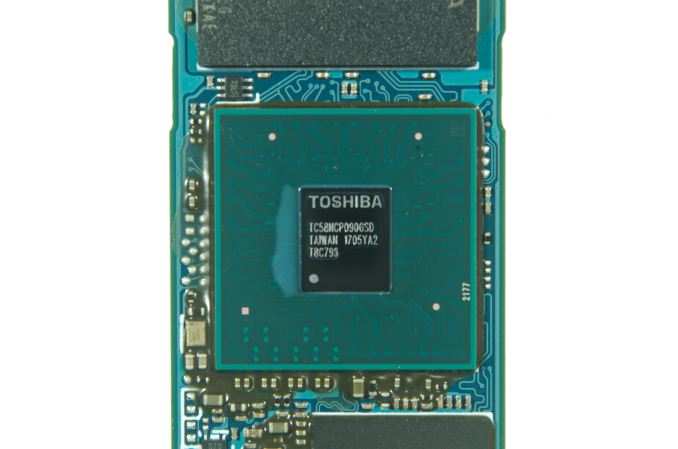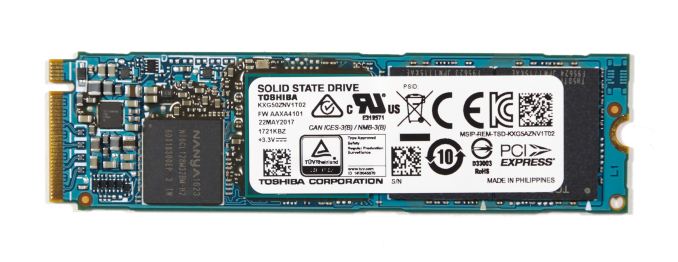
Original Link: https://www.anandtech.com/show/11663/the-toshiba-xg5-1tb-ssd-review
The Toshiba XG5 (1TB) SSD Review
by Billy Tallis on August 3, 2017 9:01 AM EST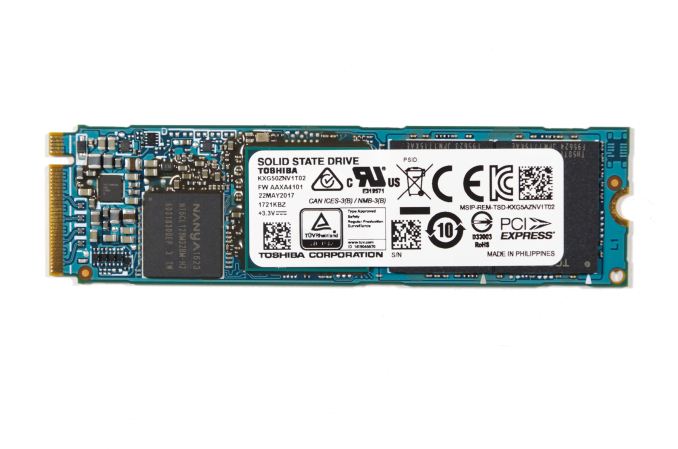
For several years, 3D NAND flash memory has promised to bring improvements to the performance, endurance and cost of SSDs. Samsung was the first to deliver 3D NAND and they have dominated the market ever since with the fastest consumer SSDs and the highest capacities. Last year, Intel and Micron shipped their first generation of 3D NAND and started providing stronger competition for Samsung in a few market segments, but price improvements were forestalled by the onset of an industry-wide shortage of NAND flash memory. Meanwhile, Toshiba, Western Digital/SanDisk, and SK Hynix talked a lot about their 3D NAND technology but shipped very little. A few memory cards and smartphones last year used 3D NAND, but Toshiba's first SSD with 3D NAND didn't enter mass production until around the beginning of this year, and it was a low-volume niche product.
Toshiba's 3D NAND, now in its third generation, is finally ready for primetime. Their first SSD based on their 64-layer BiCS3 3D NAND is the XG5 client NVMe SSD for the OEM market. Using their 3D TLC NAND, the XG5 is intended as the successor to both their XG3 and XG4 SSDs, which use 15nm planar MLC and TLC respectively. The trend of replacing planar MLC with 3D TLC is widespread across all segments of the SSD market, even for high-end enterprise SSDs. The general consensus has been that the extra capacity of TLC can make up for its performance disadvantages once the switch to 3D NAND has reduced those disadvantages. In the client space, the use of SLC write caching completely eliminates the penalty to write performance provided the workload's writes fit in that cache. Overall, Toshiba's decision to make the TLC-based XG5 their high-end OEM NVMe offering is no surprise.
The XG5 was first teased by Toshiba in May and was officially announced for Computex. The XG5 seems to have been the first 64-layer 3D NAND SSD to start shipping, but since it is an OEM product working its way through the suppy chain, it is still hard for consumers to acquire. Intel launched their 64-layer 3D NAND with the SSD 545s at the end of June and it managed to be the first 64L 3D NAND with retail availability. Since then, Western Digital has also announced their first 3D NAND SSDs, Toshiba announced their first retail 3D NAND SSD, and today Toshiba is announcing the rest of their OEM client 3D NAND SSDs. SK Hynix is still pretty quiet, but otherwise the SSD industry is finally reaching the point where most products will be based on 3D NAND. Planar NAND won't disappear for quite a while, but as production of 64L 3D NAND ramps up most brands will introduce their most significant product updates in years.
| Toshiba XG5 Specifications | |||
| Capacity | 256GB | 512GB | 1024GB |
| Controller | Toshiba TC58NCP090GSD | ||
| NAND Flash | 256Gb 64L 3D TLC | 512Gb 64L 3D TLC | |
| Sequential Read | 2700 MB/s | 3000 MB/s | 3000 MB/s |
| Sequential Write | 1050 MB/s | 1050 MB/s | 2100 MB/s |
| TCG Opal Encryption | Optional | ||
| Form Factor | single-sided M.2 2280 | ||
The Toshiba XG5 is intended to ride the wave of increasing NVMe adoption by OEMs. It uses the single-sided M.2 form factor preferred for notebooks and offers capacities from 256GB to 1TB. Higher capacities would be possible using this 3D NAND, but given the current shortage they would be too expensive for most consumers. The controller supports a PCIe 3.1 x4 link and complies with version 1.2.1 of the NVMe specification. Based on the chip markings (TC58NCP090GSD) it appears to be an updated version of the controller used by the XG3 and RD400 (TC58NCP070GSB), with a switch from plastic packaging to exposed-die flip chip packaging. The die size is approximately 39mm². The only performance specifications provided are for sequential transfers, but they're pretty aggressive for a TLC-based SSD. Toshiba wants the XG5 to cover a broad portion of the OEM SSD market.
We're still in the process of rolling out our new 2017 SSD test suite to replace the 2015 test suite. Our AnandTech Storage Bench (ATSB) tests based on real-world workloads are largely unchanged though we're reporting some of the results a bit differently. Our suite of synthetic tests has been overhauled to be more streamlined and less susceptible to producing unrealistic results due to thermal throttling or SLC write caches filling up. Most of the drives that have been tested so far are PCIe SSDs, so this review does not include any SATA drives for comparison in the graphs. This review compares the 1TB Toshiba XG5 against the following competitors:
- Samsung's 1TB 960 EVO, their current retail NVMe SSD using 3D TLC NAND. Results for the MLC-based 960 PRO and 950 PRO are also included
- Toshiba's 1TB OCZ RD400, the retail counterpart to the Toshiba XG3. The RD400 uses Toshiba's 15nm planar MLC NAND.
- Western Digital's 512GB WD Black and Intel's 512GB SSD 600p These are the cheaper TLC-based NVMe SSDs already on the market. The WD Black uses SanDisk 15nm TLC and the Intel 600p uses 32-layer 3D TLC NAND.
- Plextor M8PeY 512GB and Patriot Hellfire 480GB: Two NVMe SSDs using Toshiba's 15nm planar MLC with Marvell and Phison controllers, respectively. They have generally been cheaper than Toshiba's OCZ RD400.
- The Intel SSD 750 1.2TB, the first NVMe SSD marketed to consumers.
| AnandTech 2017 SSD Testbed | |
| CPU | Intel Xeon E3 1240 v5 |
| Motherboard | ASRock Fatal1ty E3V5 Performance Gaming/OC |
| Chipset | Intel C232 |
| Memory | 4x 8GB G.SKILL Ripjaws DDR4-2400 CL15 |
| Graphics | AMD Radeon HD 5450, 1920x1200@60Hz |
| Software | Windows 10 x64, version 1703 |
| Linux kernel version 4.12, fio version 2.21 | |
- Thanks to Intel for the Xeon E3 1240 v5 CPU
- Thanks to ASRock for the E3V5 Performance Gaming/OC
- Thanks to G.SKILL for the Ripjaws DDR4-2400 RAM
- Thanks to Corsair for the RM750 power supply, Carbide 200R case, and Hydro H60 CPU cooler
AnandTech Storage Bench - The Destroyer
The Destroyer is an extremely long test replicating the access patterns of very IO-intensive desktop usage. A detailed breakdown can be found in this article. Like real-world usage, the drives do get the occasional break that allows for some background garbage collection and flushing caches, but those idle times are limited to 25ms so that it doesn't take all week to run the test. These AnandTech Storage Bench (ATSB) tests do not involve running the actual applications that generated the workloads, so the scores are relatively insensitive to changes in CPU performance and RAM from our new testbed, but the jump to a newer version of Windows and the newer storage drivers can have an impact.
We quantify performance on this test by reporting the drive's average data throughput, the average and 99th percentile latency of the I/O operations, and the total energy used by the drive over the course of the test.
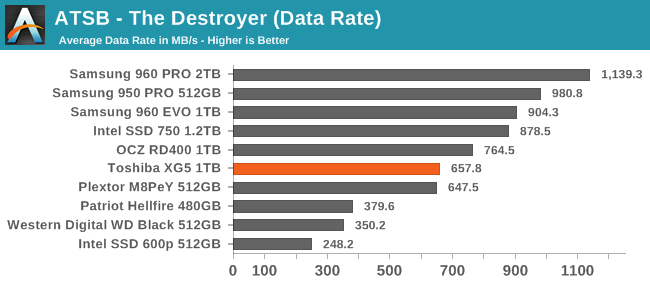
The Toshiba XG5's average data rate on The Destroyer isn't fast enough to compete with Samsung's drives, but it beats some of the slower MLC-based PCIe SSDs and is much faster than the other (non-Samsung) TLC SSDs.
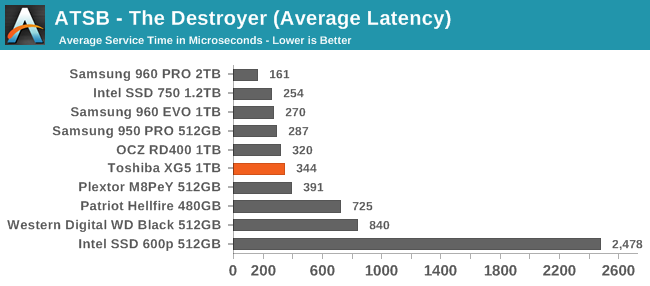
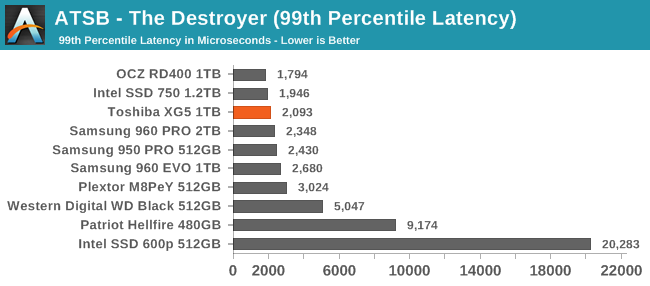
The average latency of the XG5 on The Destroyer is slower than the top NVMe SSDs including the Samsung 960 EVO, but the XG5's performance is still decent. The TLC-based WD Black and Intel 600p have average latencies that are several times higher. The 99th percentile latency of the Toshiba XG5 is very good, with a third-place score that beats all of Samsung's SSDs.
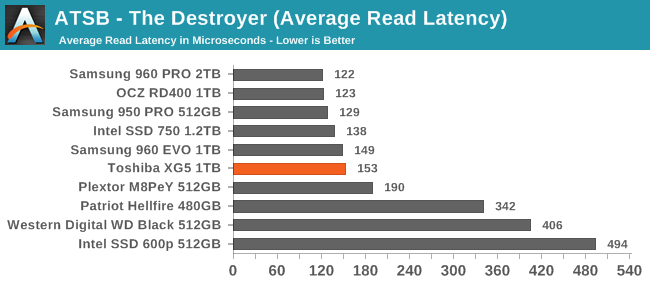
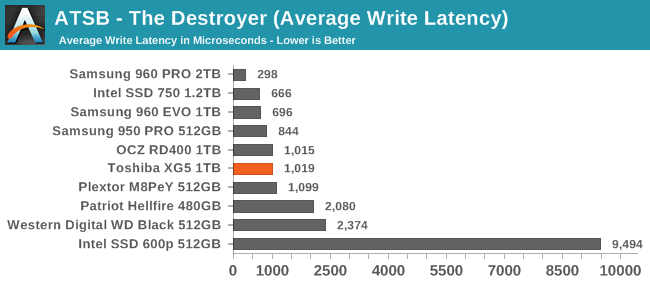
The drive rankings for average read and write latencies are very similar, with the Toshiba XG5 scoring in the middle of the pack on both measures. The overall spread of scores is very different: while the XG5's average read latency is only 25% slower than the fastest SSD and is essentially tied with the Samsung 960 EVO, its average write latency is almost 3.5 times worse than the fastest drive.
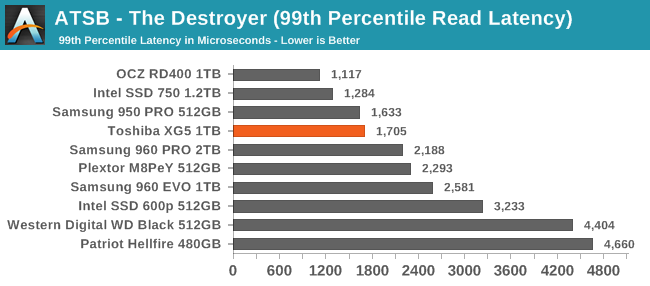
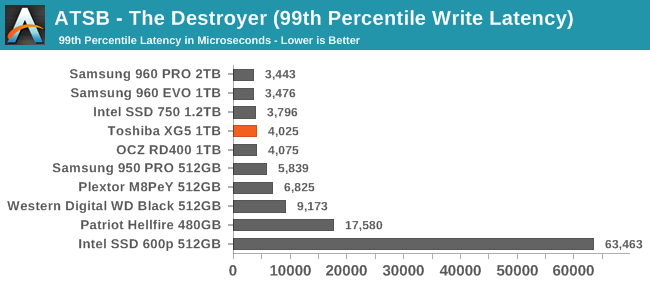
The 99th percentile latency scores of the XG5 are great for a TLC SSD. The write latency places the XG5 in the top tier of drives, while its read score is better than average among a widely varying bunch. The Intel SSD 750 is the only drive that offers better 99th percentile latency for both read and write operations.
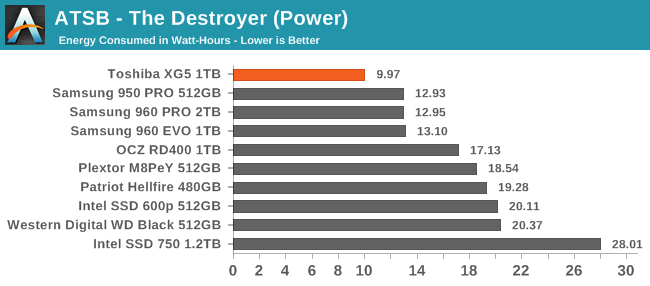
Only a handful of drives have ever completed The Destroyer while using less energy than the Toshiba XG5. Most of those were SM2246EN-based SATA drives, and a few other SATA SSDs. The Crucial MX300 and Intel 545s are the only other TLC SSDs with this kind of efficiency. None of the other NVMe SSDs come close; the fastest competitors sacrifice power efficiency to obtain that performance, and the slower NVMe SSDs waste too much power operating a PCIe link that they can't fully utilize.
AnandTech Storage Bench - Heavy
Our Heavy storage benchmark is proportionally more write-heavy than The Destroyer, but much shorter overall. The total writes in the Heavy test aren't enough to fill the drive, so performance never drops down to steady state. This test is far more representative of a power user's day to day usage, and is heavily influenced by the drive's peak performance. The Heavy workload test details can be found here. This test is run twice, once on a freshly erased drive and once after filling the drive with sequential writes.
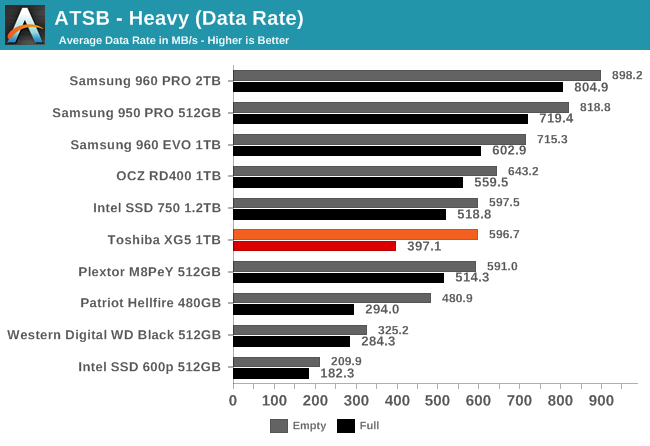
The Toshiba XG5's average data rate on the Heavy test is not quite competitive with the Samsung 960 EVO and also trails behind Toshiba's OCZ RD400, but it ties or beats several MLC SSDs and fares far better than the WD Black and Intel 600p. The XG5 does suffer a relatively large performance hit when the test is run on a full drive, but even in that case it is still substantially faster than the SSDs that it beats when the test is run on an empty drive.
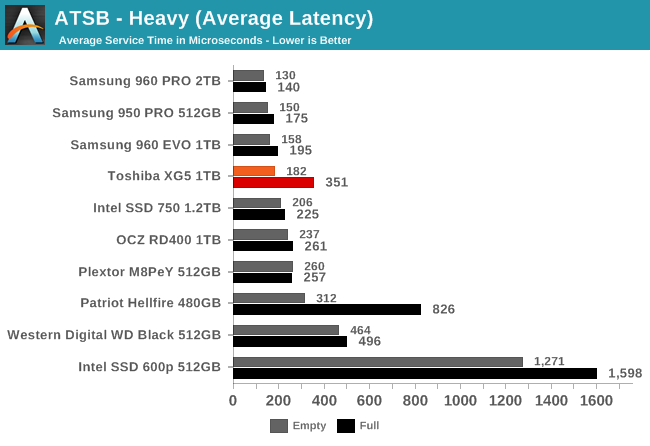
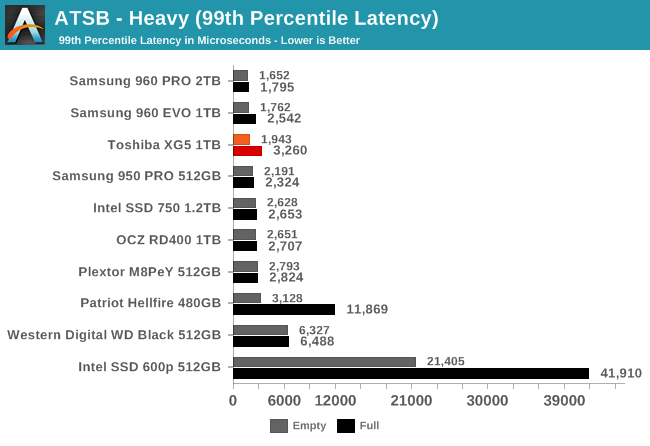
When the Heavy test is run on an empty drive, the XG5's average and 99th percentile latency are just shy of Samsung's NVMe SSDs and ahead of the Intel SSD 750. When the test is run on a full drive the latencies are increased significantly, but this still leaves the XG5 ahead of the slowest MLC-based NVMe SSDs.
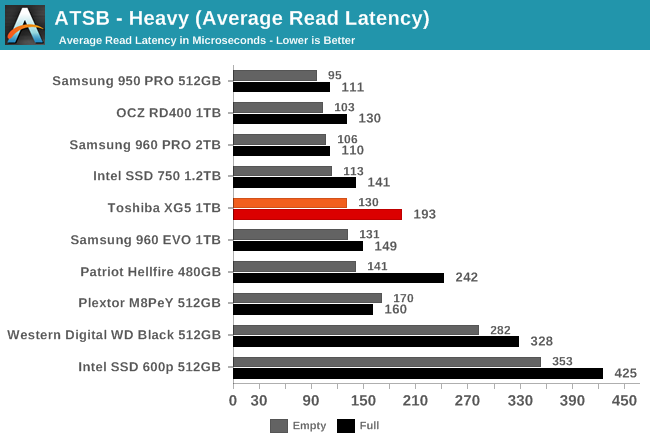
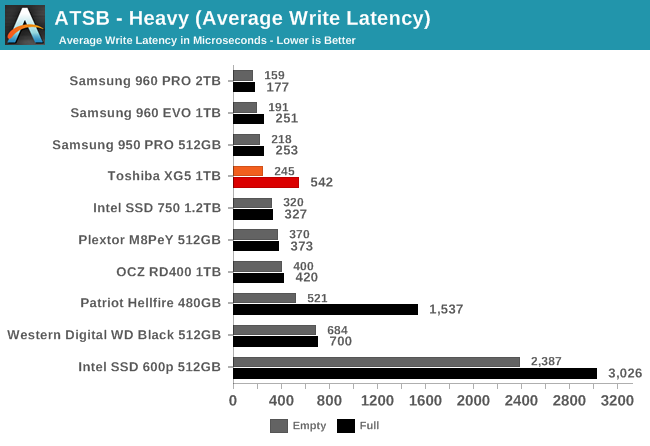
Separating the average read and write latencies shows that the XG5 performs well with both types of operation. The full-drive penalty affects writes more than reads, but the overall wider spread of write latencies means the XG5 still isn't close to the bottom of the charts for that test.
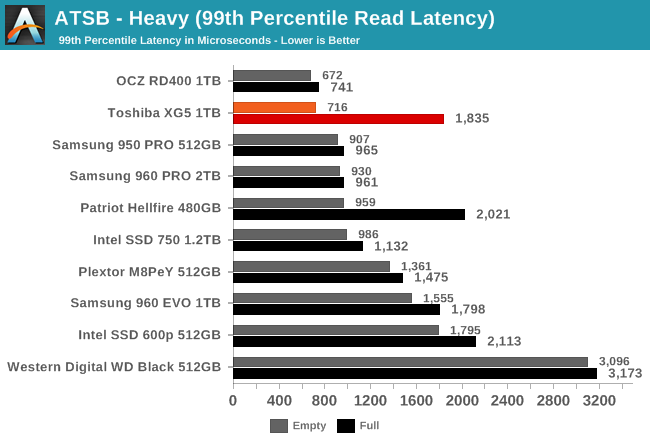
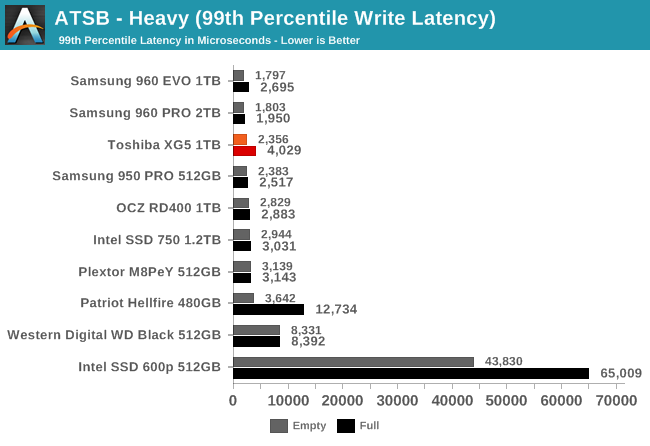
The 99th percentile read latencies show one of the XG5's greatest strengths with a clear advantage over Samsung's best SSD when the test is run on an empty drive, but the full-drive penalty is acute and pushes the 99th percentile latency 2.5 times higher. The Samsung 960 EVO performs poorly here with scores worse than most MLC NVMe SSDs and just ahead of the Intel 600p.
The 99th percentile write latencies paint a very different picture. Only a few drives have trouble keeping write latency under control, and the XG5 clearly isn't one of them, even when full.
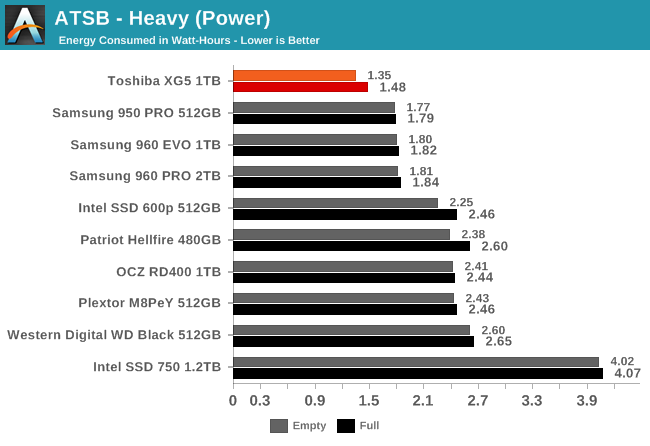
The Toshiba XG5's energy usage on the Heavy test is again much better than any previous PCIe SSD. There's a clear increase in energy consumption when the test is run on a full drive, but the effect is much smaller than the performance impact and is not enough to knock the XG5 out of first place.
For context, the energy usage of the XG5 is on par with the most efficient SATA SSDs based on planar TLC, but is not competitive with SATA SSDs using MLC or 3D NAND. Those SATA results are not shown here because they were recorded on our earlier 2015 testbed running Windows 8.1, but they should be quite similar to how those drives will perform on the new 2017 testbed.
AnandTech Storage Bench - Light
Our Light storage test has relatively more sequential accesses and lower queue depths than The Destroyer or the Heavy test, and it's by far the shortest test overall. It's based largely on applications that aren't highly dependent on storage performance, so this is a test more of application launch times and file load times. This test can be seen as the sum of all the little delays in daily usage, but with the idle times trimmed to 25ms it takes less than half an hour to run. Details of the Light test can be found here. As with the ATSB Heavy test, this test is run with the drive both freshly erased and empty, and after filling the drive with sequential writes.
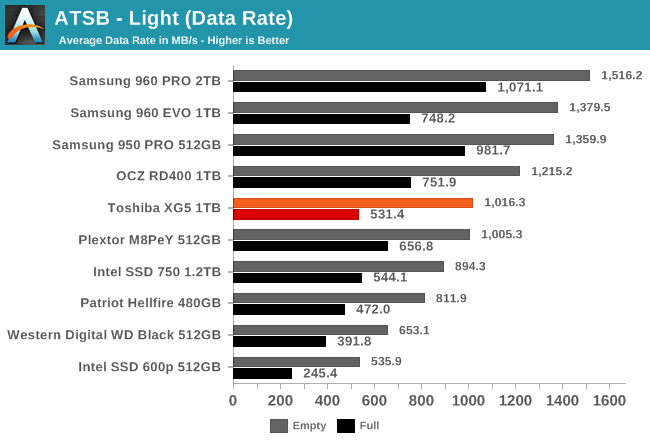
The Toshiba XG5's average data rate on the Light test ranks it similarly to how it ranked on The Destroyer and the Heavy test. The overall spread of scores is not as large on the Light test, and the Intel SSD 750 falls behind the XG5 for once. The disparity in performance between running the Light test on a full drive and an empty drive is bigger than it was on the Heavy test, but the Samsung 960 EVO also suffers by almost as much.
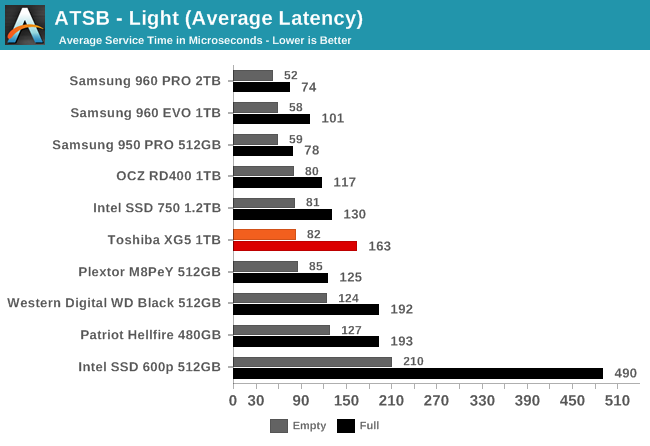
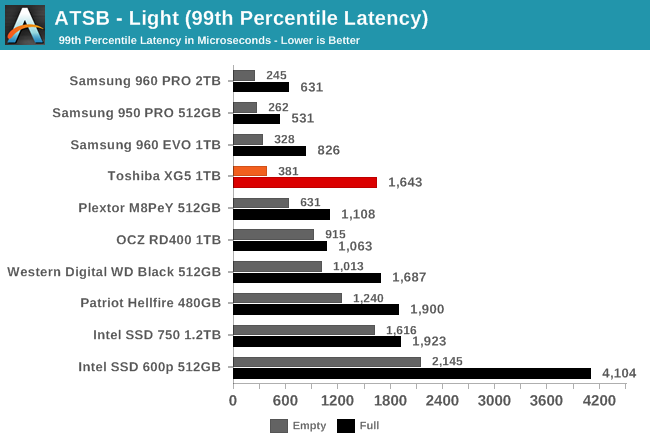
When the Light test is run on an empty drive, the XG5's average latency puts it in the second tier of NVMe SSDs, virtually tied with the RD400, Intel 750, and Plextor M8Pe. The 99th percentile latency of the XG5 is much closer to the Samsung drives at the top of the chart than to any of the other competitors.
When the Light test is run on a full drive, the XG5's average and 99th percentile latency are only slightly ahead of the slow TLC drives and the Phison E7-based Patriot Hellfire.
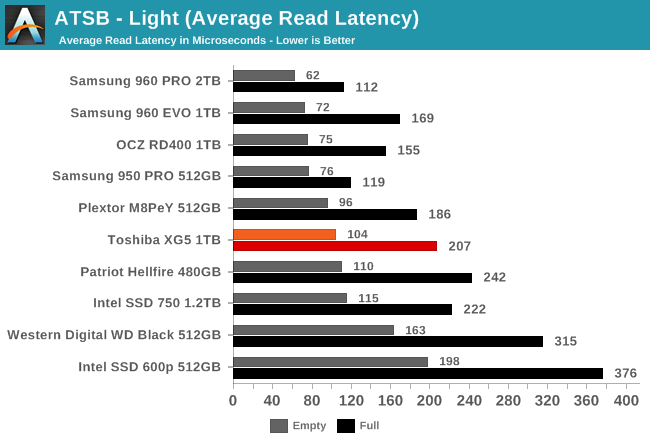
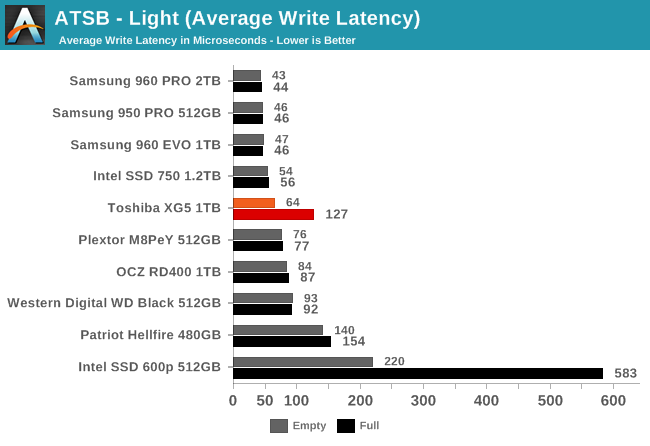
The average read latency scores on the Light test place the XG5 in the middle of the pack. Even though almost all drives show substantially higher read latency when full, everything is plenty fast and the differences in won't matter in practice. The average write latency scores are similarly closely clustered and almost all very fast, but the Toshiba XG5 stands out as one of the two drives that scores significantly worse when full.
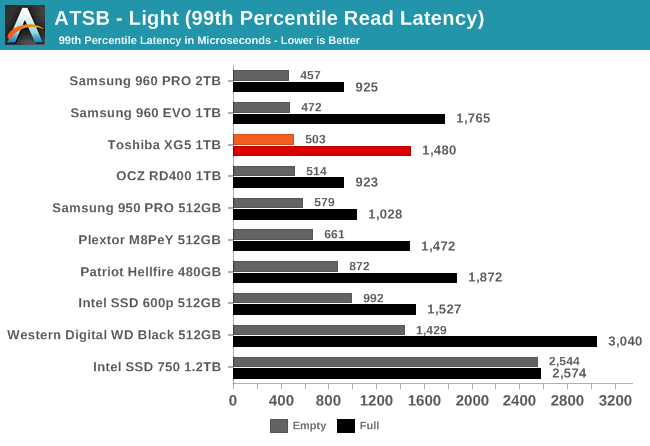
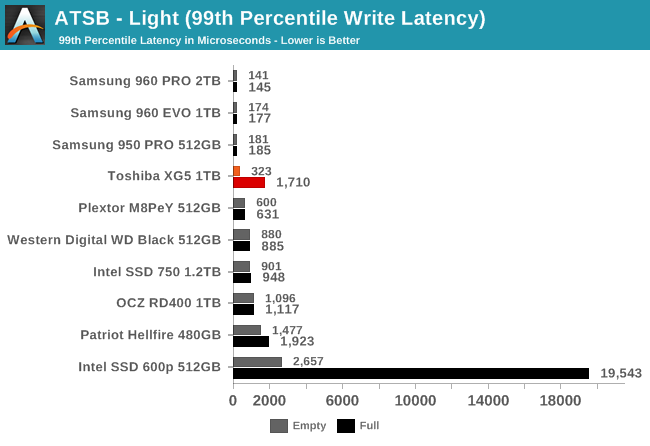
The 99th percentile read latency of the Toshiba XG5 on the Light test is very good, trailing just behind the Samsung 960 EVO when the test is run on an empty drive and scoring modestly better than the 960 EVO when the drives are full. The 99th percentile write latency of the XG5 isn't as close to Samsung but is still great then the drive starts out empty. When it's full, the XG5 does start to lose its stellar quality of service but doesn't land all the way at the bottom of the chart.
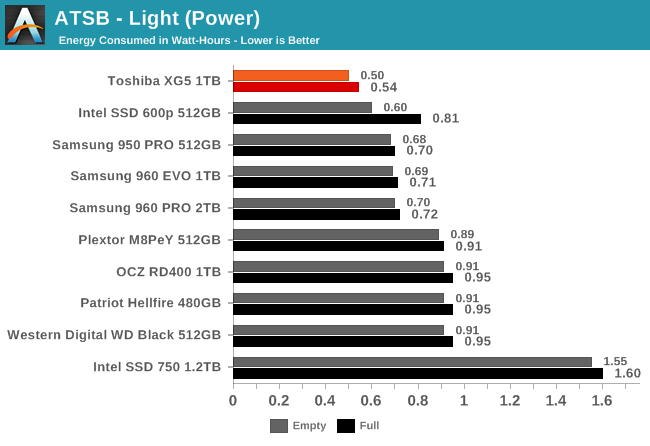
The Toshiba XG5 continues its sweep of the energy efficiency scores with another record for NVMe SSDs. The Samsung drives use more than 30% more energy over the course of the Light test, and most of the competition is closer to 70-80% more power hungry.
Random Read Performance
Our first test of random read performance uses very short bursts of operations issued one at a time with no queuing. The drives are given enough idle time between bursts to yield an overall duty cycle of 20%, so thermal throttling is impossible. Each burst consists of a total of 32MB of 4kB random reads, from a 16GB span of the disk. The total data read is 1GB.
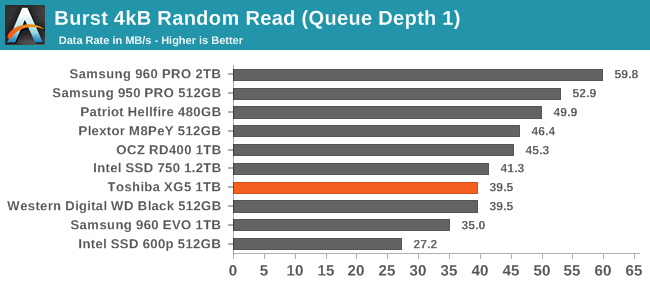
The Toshiba XG5 is tied for the position of fastest TLC SSD, sharing that position with the WD Black. The Samsung 960 EVO is about 11% slower, and all of the MLC drives are faster—over 50% faster in the case of Samsung's 960 PRO.
Our sustained random read performance is similar to the random read test from our 2015 test suite: queue depths from 1 to 32 are tested, and the average performance and power efficiency across QD1, QD2 and QD4 are reported as the primary scores. Each queue depth is tested for one minute or 32GB of data transferred, whichever is shorter. After each queue depth is tested, the drive is given up to one minute to cool off so that the higher queue depths are unlikely to be affected by accumulated heat build-up. The individual read operations are again 4kB, and cover a 64GB span of the drive.
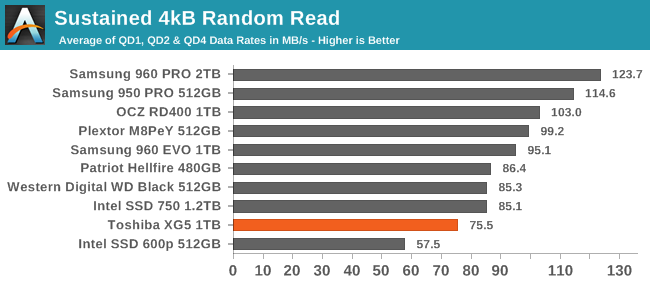
When slightly higher queue depths and longer run times come into the picture, the XG5's random read performance looks worse. The XG5 ends up second from last place among PCIe SSDs, with both the WD Black and the Samsung 960 EVO leaping ahead of the XG5.
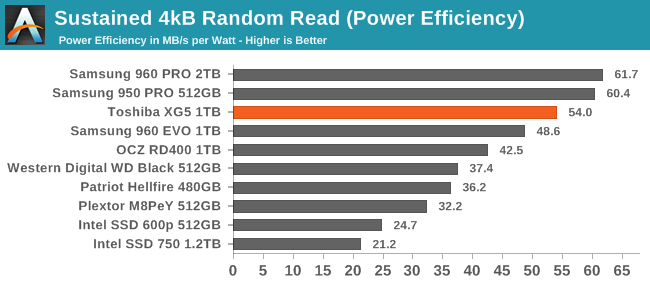
In spite of relatively poor random read performance, the XG5 continues to deliver great power efficiency that is clearly better than any previous TLC PCIe SSD, including the 960 EVO.
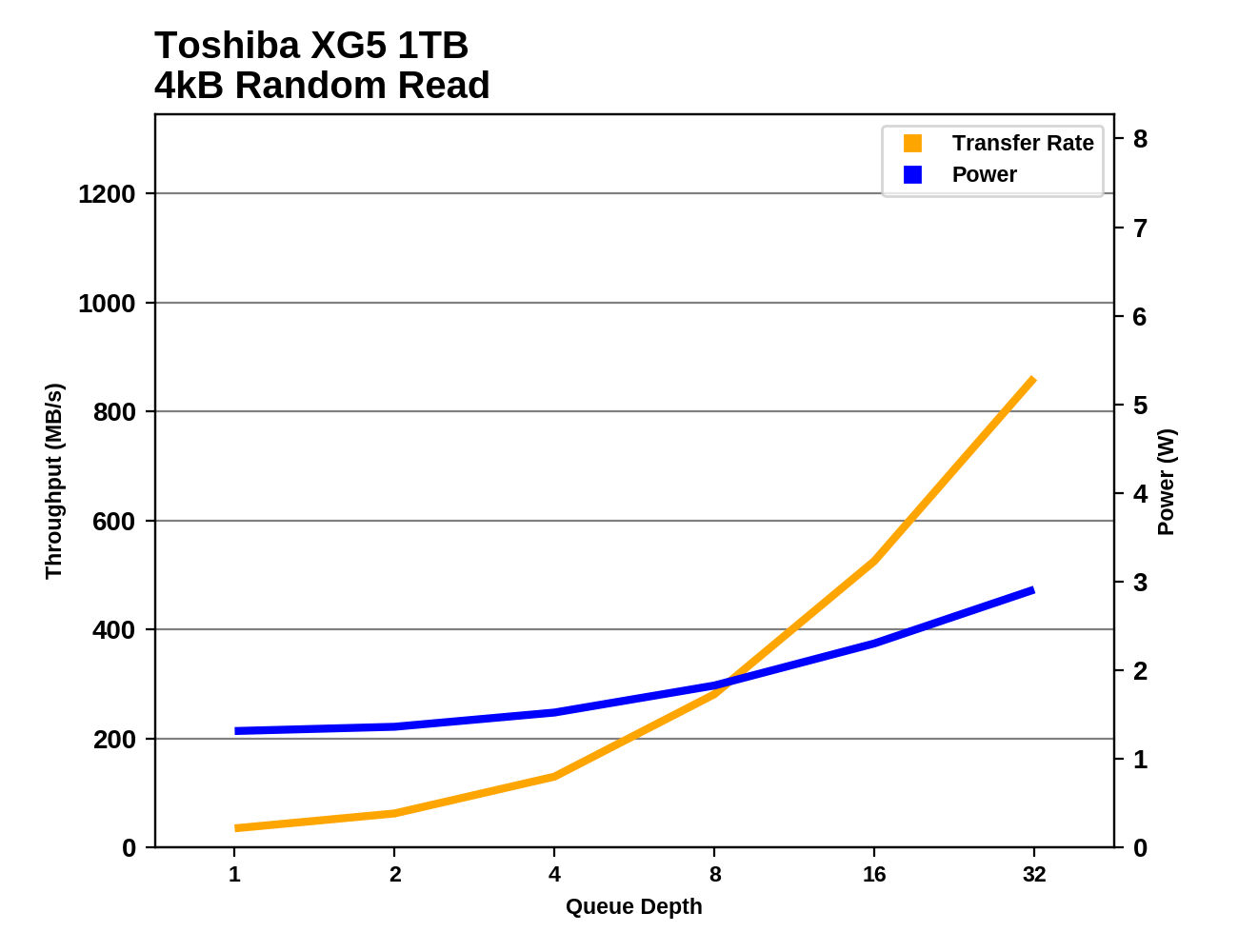 |
|||||||||
At every queue depth of the sustained random read test, the Toshiba XG5 uses less power than any competing NVMe SSDs, and it's the only one in this batch to stay under 3W for the whole test. Most of those competitors can ramp up performance faster as the queue depth increases, but the XG5's scaling difficulties aren't very serious.
Random Write Performance
Our test of random write burst performance is structured similarly to the random read burst test, but each burst is only 4MB and the total test length is 128MB. The 4kB random write operations are distributed over a 16GB span of the drive, and the operations are issued one at a time with no queuing.
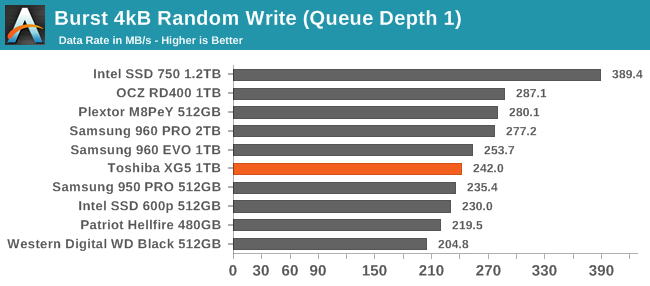
The Toshiba XG5's QD1 random write performance is about average for NVMe SSDs; only the Intel SSD 750 with its enterprise heritage is a significant outlier.
As with the sustained random read test, our sustained 4kB random write test runs for up to one minute or 32GB per queue depth, covering a 64GB span of the drive and giving the drive up to 1 minute of idle time between queue depths to allow for write caches to be flushed and for the drive to cool down.
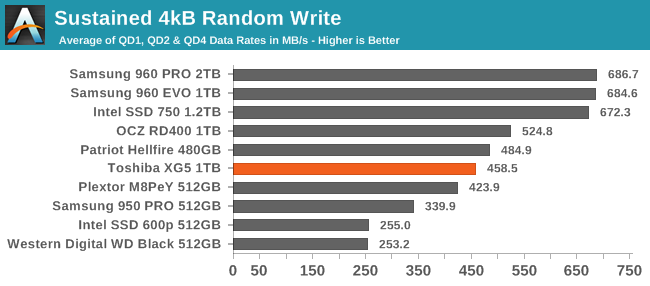
The Toshiba XG5's sustained random write performance is far lower than the Samsung 960s or the Intel 750, but the XG5 is still about average for a NVMe SSD even when MLC SSDs are included. The Intel 600p and WD Black offer barely half the random write throughput of the XG5.
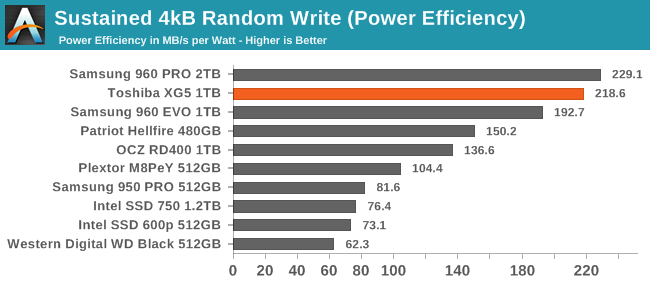
The XG5's power efficiency is a close second behind the Samsung 960 PRO, and clearly ahead of the 960 EVO. The XG5's efficiency is three times higher than the TLC-based Intel 600p or WD Black.
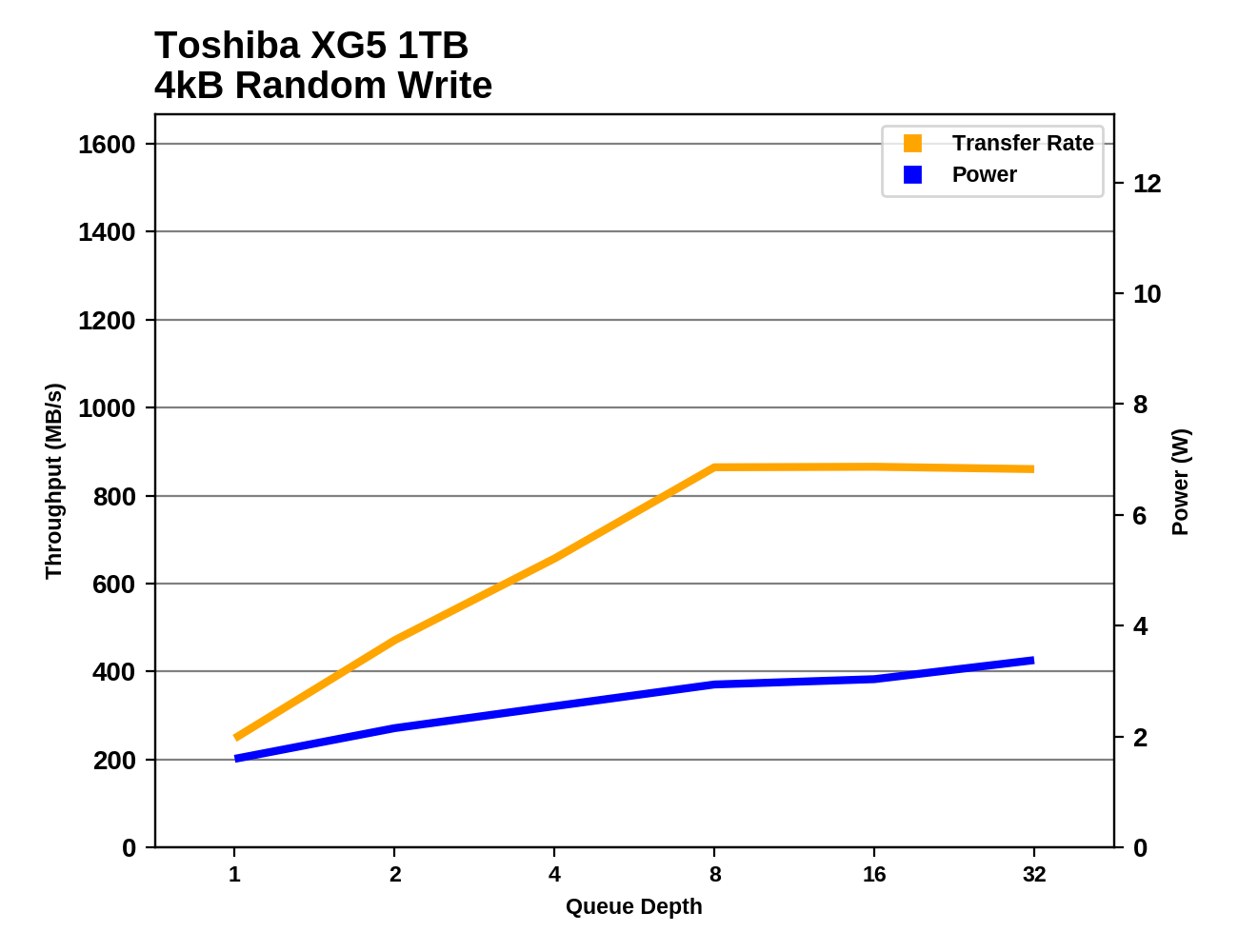 |
|||||||||
The Toshiba XG5's random write performance flattens out at QD8, which is around where most of the high-performing drives saturate. Unfortunately, the performance of the XG5 when it reaches its limit is nothing remarkable. The XG5's power consumption does remain by far the lowest even across the entire test, though its efficiency is not always superior to the Samsung 960 PRO.
Sequential Read Performance
Our first test of sequential read performance uses short bursts of 128MB, issued as 128kB operations with no queuing. The test averages performance across eight bursts for a total of 1GB of data transferred from a drive containing 16GB of data. Between each burst the drive is given enough idle time to keep the overall duty cycle at 20%.
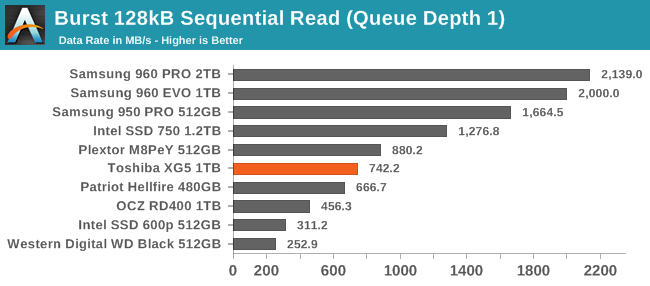
The sequential read speed of the Toshiba XG5 at queue depth 1 is quite disappointing compared to the Samsung 960 EVO. The XG5 does well compared to the other TLC SSDs and several MLC SSDs, including Toshiba's OCZ RD400.
Our test of sustained sequential reads uses queue depths from 1 to 32, with the performance and power scores computed as the average of QD1, QD2 and QD4. Each queue depth is tested for up to one minute or 32GB transferred, from a drive containing 64GB of data.
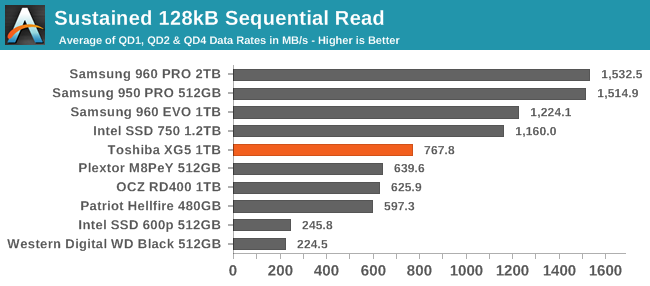
The Samsung NVMe SSDs don't perform quite as well on the longer sequential read test, so their performance lead over the Toshiba XG5 is diminished to about a factor of two. The XG5's ranking is slightly improved, and it is only outperformed by Samsung and the Intel 750.
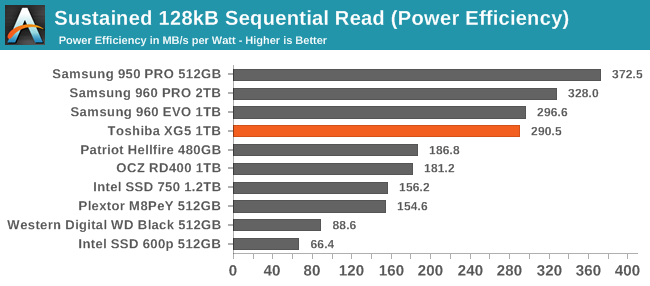
The Toshiba XG5's performance on the sustained sequential read test is low enough that it doesn't beat Samsung's drives on efficiency, though it does almost tie the Samsung 960 EVO. All the other drives are far less efficient.
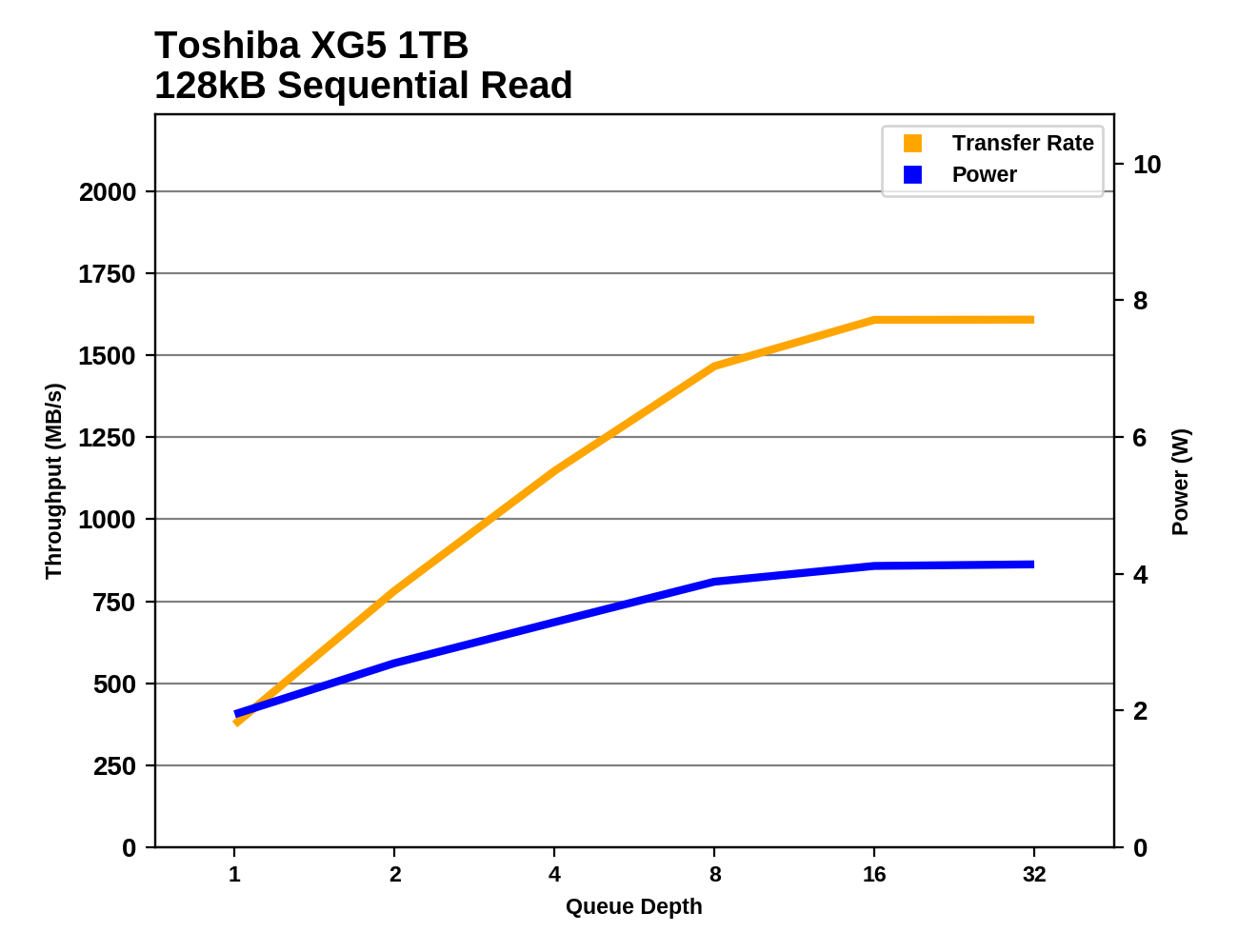 |
|||||||||
The Toshiba XG5's sequential read performance doesn't reach full speed until QD16, much later than most drives, especially Samsung's 960 PRO and EVO which offer nearly full speed at QD1. When it does saturate, the XG5 is delivering the same write performance as the Samsung 960 PRO, which is substantially faster than the 960 EVO.
The WD Black and the Patriot Hellfire are the only two drives in this batch that use less power than the XG5 at any point during this test. Their performance is not even close to competitive with the XG5 when they manage to use less power.
Sequential Write Performance
Our test of sequential write burst performance is structured identically to the sequential read burst performance test save for the direction of the data transfer. Each burst writes 128MB as 128kB operations issued at QD1, for a total of 1GB of data written to a drive containing 16GB of data.

With ideal conditions to take advantage of SLC write caching, the Toshiba XG5 delivers great sequential write performance. It's not quite as fast as Samsung's drives, but it is ahead of everything else including a slight lead over the Intel 750.
Our test of sustained sequential writes is structured identically to our sustained sequential read test, save for the direction of the data transfers. Queue depths range from 1 to 32 and each queue depth is tested for up to one minute or 32GB, followed by up to one minute of idle time for the drive to cool off and perform garbage collection. The test is confined to a 64GB span of the drive.
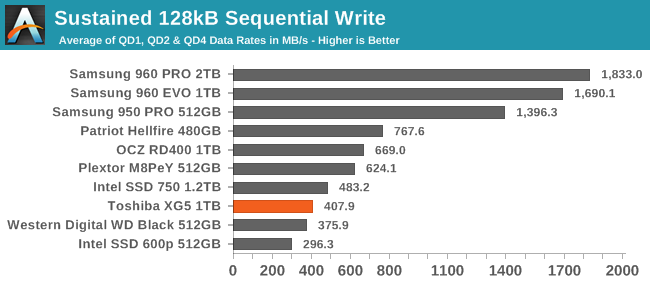
The longer run times of our sustained sequential write test have a huge impact on the Toshiba XG5's performance: instead of outperforming everything except Samsung's SSDs, it slows down to SATA-like speeds and is only faster than the WD Black and the Intel 600p. Meanwhile, the Samsung 960 EVO holds on to second place and is only slightly slower than its burst performance.

In spite of its poor performance, the Toshiba XG5's power efficiency is still decent (by NVMe standards) on the longer sequential write test, but it's not even close to being competitive with Samsung's drives. The 960 EVO offers almost twice the performance per Watt during sustained writes.
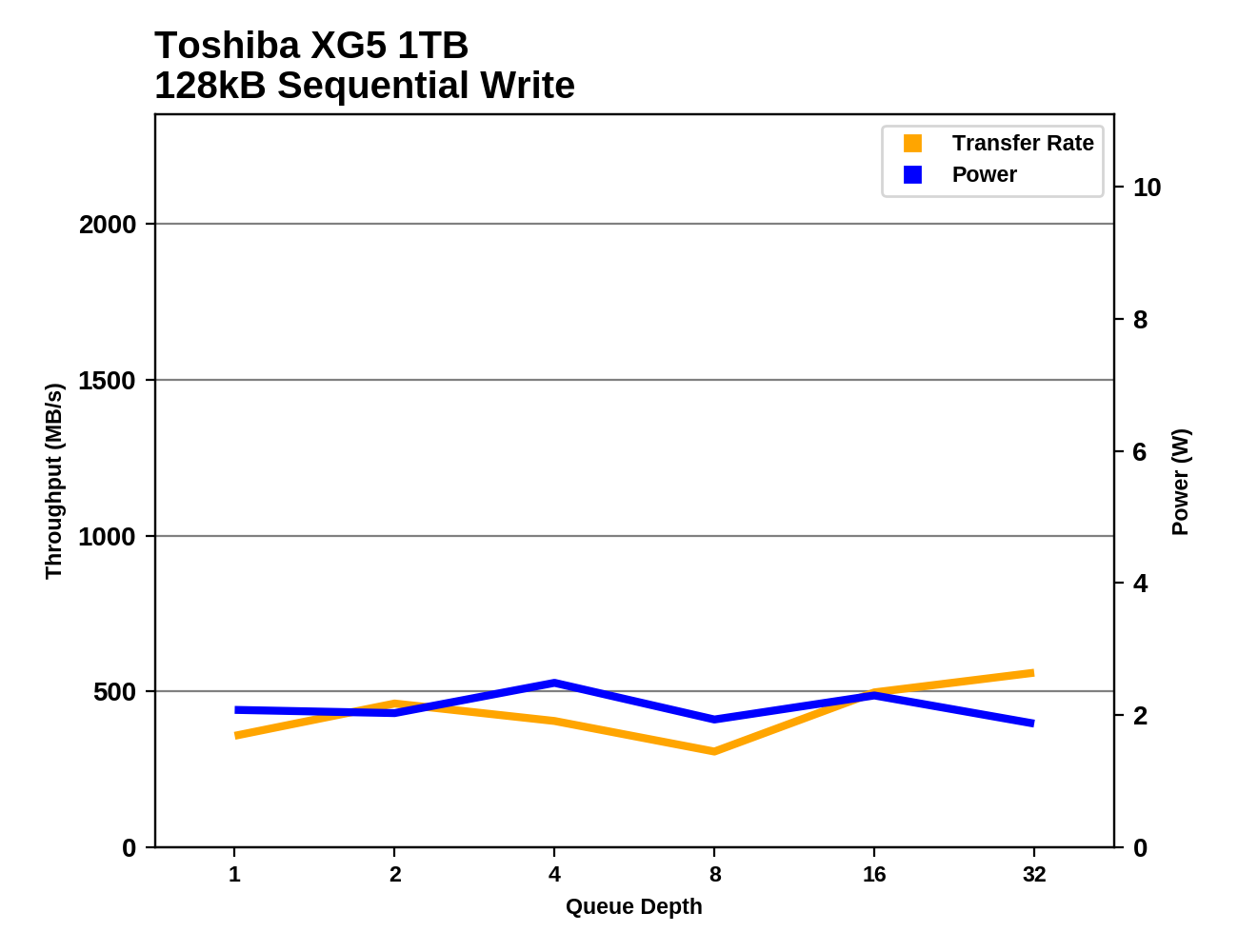 |
|||||||||
The performance and power consumption of the Toshiba XG5 bounce around over the course of the sustained sequential write test as it spends a large portion of its time dealing with a filled SLC write cache. Most competing NVMe SSDs offer far more consistent performance and saturate with a queue depth of two. The power draw of the XG5 averages around 2W while most of the other drives are pulling 4W or more.
Mixed Random Performance
Our test of mixed random reads and writes covers mixes varying from pure reads to pure writes at 10% increments. Each mix is tested for up to 1 minute or 32GB of data transferred. The test is conducted with a queue depth of 4, and is limited to a 64GB span of the drive. In between each mix, the drive is given idle time of up to one minute so that the overall duty cycle is 50%.
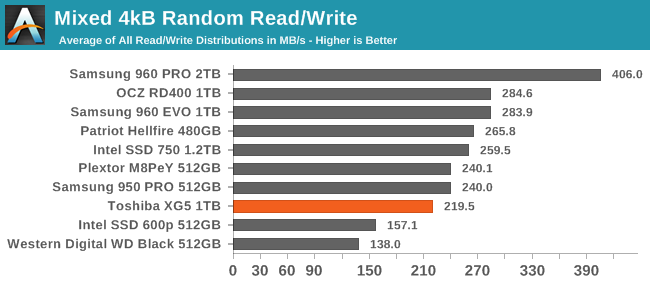
The Toshiba XG5 ranks near the bottom for mixed random I/O performance, but it is only moderately slower than average, with more than three quarters the performance of the Samsung 960 EVO. The Intel 600p and WD Black are substantially slower, while the Samsung 960 PRO is a major outlier at the top of the chart.
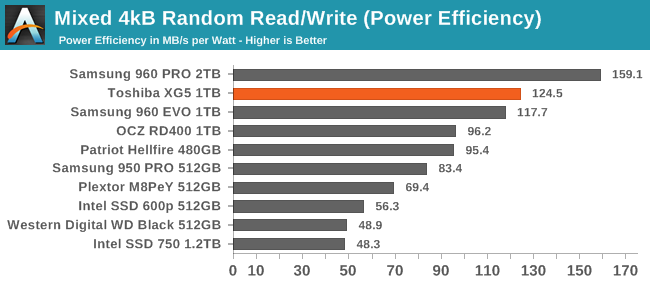
The Toshiba XG5 delivers better power efficiency than any NVMe SSD save for the Samsung 960 PRO. The 960 EVO's efficiency is close to that of the XG5, and the other TLC SSDs are at the bottom of the chart with less than half the performance per Watt.
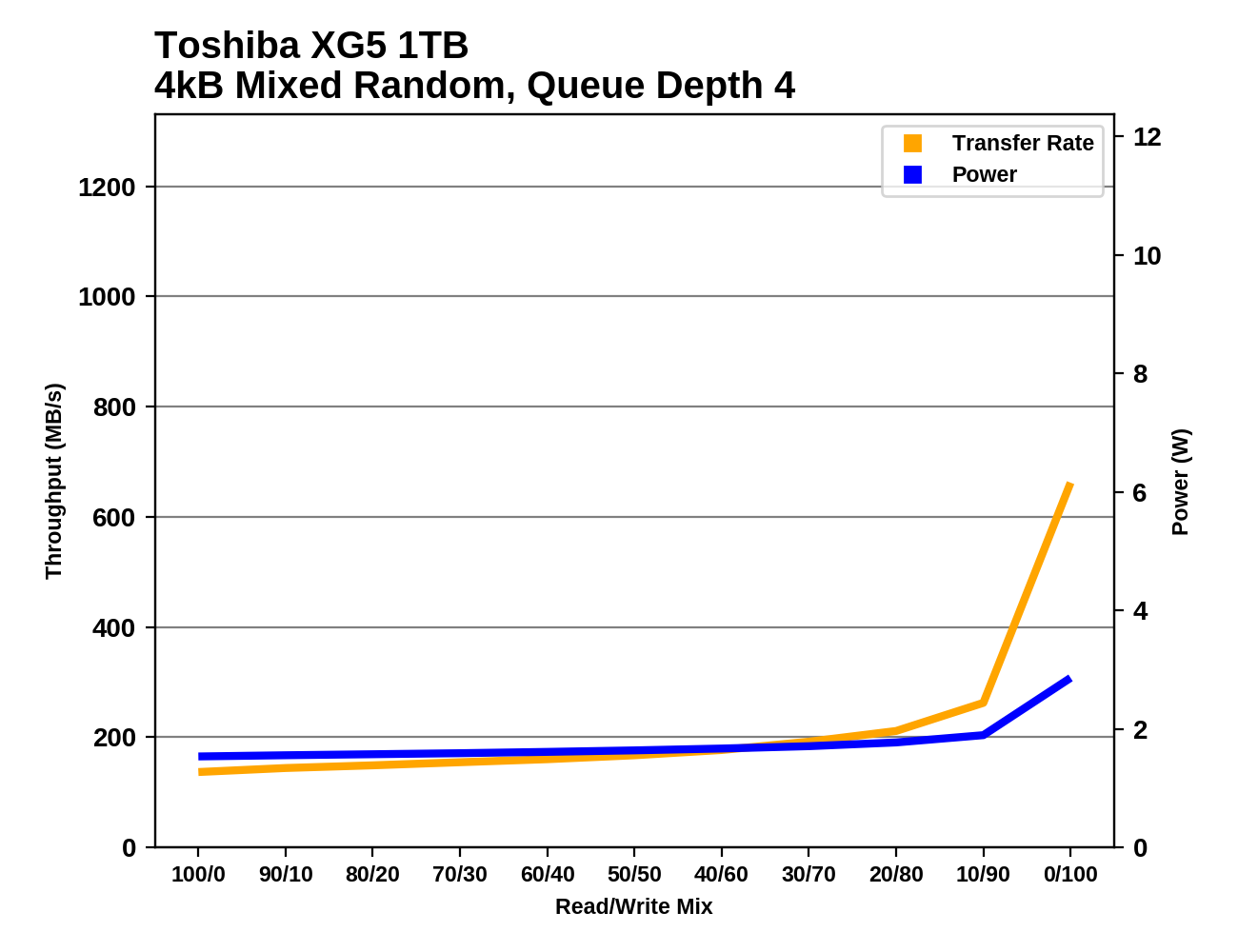 |
|||||||||
The Toshiba XG5's performance across the mixed random I/O test is mostly flat until near the very end. It's typical for performance to spike once most of the operations are writes that can be efficiently combined and cached. The performance spike the XG5 experiences is only half the boost the 960 EVO gets, which accounts for almost all of the difference in their average performance scores. Most of the drives perform very similarly across most of the test, with only the Intel 600p and the WD Black showing substantially worse performance across large portions of the test.
Mixed Sequential Performance
Our test of mixed sequential reads and writes differs from the mixed random I/O test by performing 128kB sequential accesses rather than 4kB accesses at random locations, and the sequential test is conducted at queue depth 1. The range of mixes tested is the same, and the timing and limits on data transfers are also the same as above.
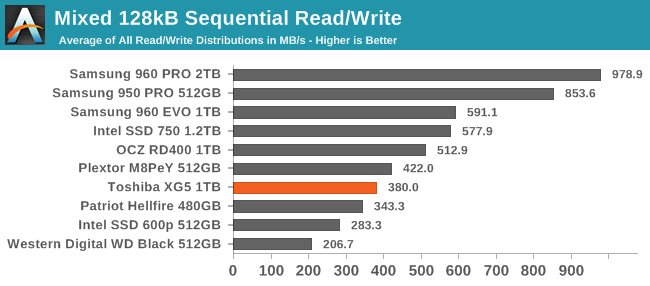
As with the mixed random I/O test, the Toshiba XG5 is slower than average on the mixed sequential I/O test. The Samsung 960 EVO is only outperformed by Samsung's MLC-based PCIe SSDs, which have a large lead.
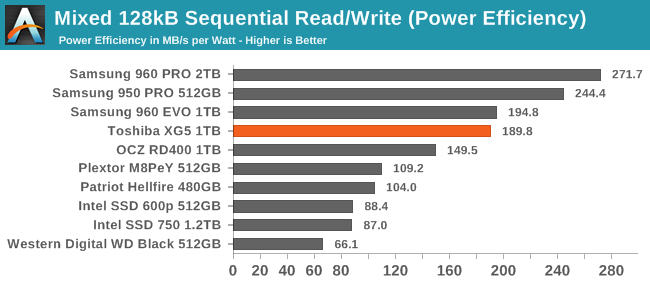
The XG5 almost ties the 960 EVO for power efficiency and is the only drive that comes close to Samsung's efficiency.
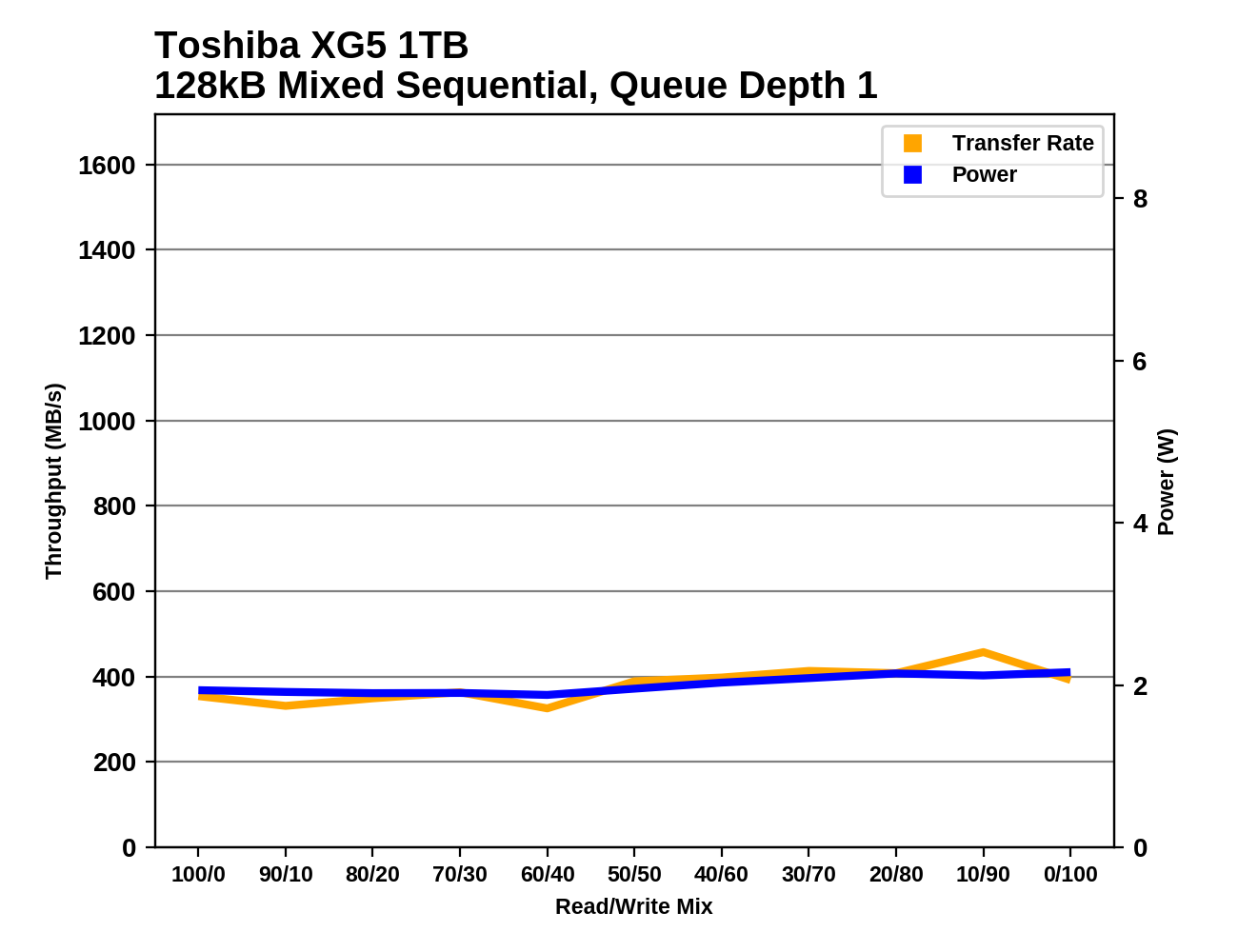 |
|||||||||
The Toshiba XG5's performance varies slightly over the course of the mixed sequential test but the overall trend is flat. Power usage is also quite steady at around 2W. The best-performing drives exhibit a bathtub curve of performance that bottoms out around a 50/50 or 40/60 read/write mix, while most of the other drives show gradual increases as the portion of writes grows, followed by a more dramatic spike at the end of the test.
The Samsung 960 EVO comes closest to matching the power consumption of the Toshiba XG5, but only when its performance bottoms out at about two-thirds of what the XG5 provides.
Power Management
Real-world client storage workloads leave SSDs idle most of the time, so the active power measurements presented earlier in this review only account for a small part of what determines a drive's suitability for battery-powered use. Especially under light use, the power efficiency of a SSD is determined mostly be how well it can save power when idle.
Idle power management for NVMe SSDs is far more complicated than for SATA SSDs. NVMe SSDs can support several different idle power states, and through the Autonomous Power State Transition (APST) feature the operating system can set a drive's policy for when to drop down to a lower power state. There is typically a tradeoff in that lower-power states take longer to enter and wake up from, so the choice about what power states to use may differ for desktop and notebooks.
We report two idle power measurements. Active idle is representative of a typical desktop, where none of the advanced PCIe link or NVMe power saving features are enabled and the drive is immediately ready to process new commands. The idle power consumption metric is measured with PCIe Active State Power Management L1.2 state enabled and NVMe APST enabled.
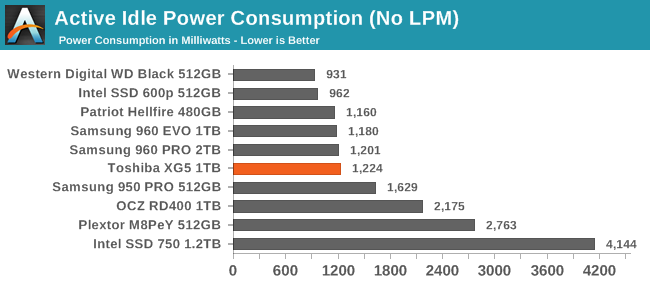
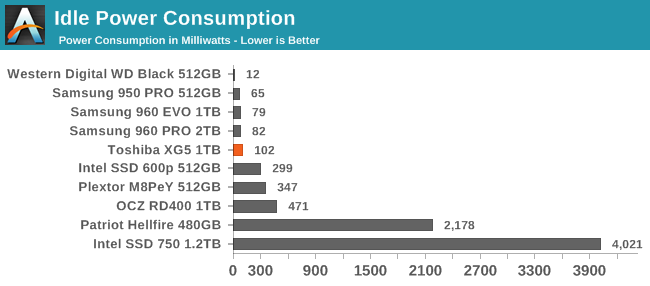
The active power consumption of the Toshiba XG5 is very close to that of Samsung's 960 PRO and EVO, but the WD Black and Intel 600p are even better. However, all of these drives have much higher active idle power use than is typical for SATA SSDs.
The idle power consumption of the XG5 with all the power-saving features turned on is again close to Samsung, but slightly higher and the WD Black puts even Samsung to shame.
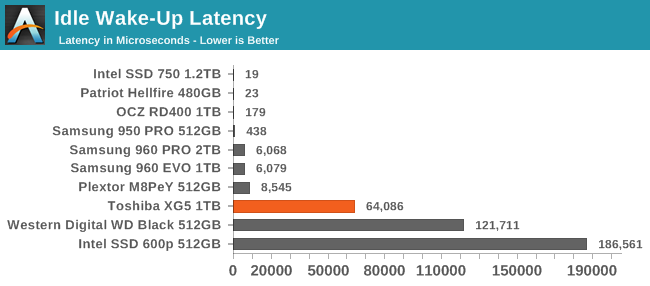
The wake-up latencies from the idle power states reported above vary widely. The Intel SSD 750 doesn't support any of the advanced power management features of NVMe and thus has a minimal wake-up latency. The Patriot Hellfire's APST implementation is broken, causing it to also not use any power saving mode on our testbed. While the Toshiba XG5 was close to Samsung in terms of power saved, its wake-up latency is an order of magnitude higher than that of the 960 PRO and 960 EVO, and almost 150 times higher than the 950 PRO. The WD Black clearly pays a price for its great power saving with a wake-up latency of over 120ms.
Conclusion
The Toshiba XG5 isn't the fastest NVMe SSD; its use of TLC NAND and its reliance on SLC caching do hurt it in some scenarios, and Samsung's TLC-based 960 EVO is usually faster, sometimes by a wide margin. But for typical client and consumer workloads the XG5 offers very good mainstream performance that is competitive with many MLC-based NVMe SSDs. The drive that the XG5 most often ties with on performance is the Plextor M8Pe, which uses Toshiba 15nm planar MLC and a Marvell controller. Our M8Pe results are somewhat handicapped by our 512GB M8Pe sample being at a capacity disadvantage, but normally the use of TLC would be a bigger handicap.
Samsung's NVMe performance records are hard to beat, and Toshiba wasn't really trying for that with the XG5, though its performance is certainly good enough for the intended uses. Where Toshiba has raised the bar is power efficiency. The XG5 is one of the most power efficient PCIe SSDs on the market, in spite of using TLC NAND. Its efficiency is sometimes beat by some of Samsung's NVMe drives on tests that hit the XG5's most acute performance weaknesses, but on more real-world tests the XG5 is the clear winner.
As a successor to Toshiba's MLC-based OCZ RD400, the XG5 doesn't bring any significant performance improvement and is usually a bit slower. When Toshiba gets around to launching a true retail replacement for the RD400 we may see some modest performance increases due to firmware tweaks, possibly sacrificing some power efficiency in the process. For now as an OEM product, the XG5's advantages of lower cost, lower power consumption and a single-sided 1TB model are clearly worth the performance sacrifice.
We've had occasion in the past to complain about high-end laptops advertising NVMe SSDs but shipping with relatively disappointing TLC-based drives. The XG5 will not provide the same disappointment. Its performance is worthy of an expensive machine and its power efficiency makes it undoubtedly the best choice for OEMs to adopt.
In desktops or for laptops that don't really care about battery life, the XG5 is not an obvious winner and the decision comes down to pricing that isn't publicly available for OEM products. When Toshiba comes out with a retail counterpart to the XG5 it will not offer a significant performance upgrade over their OCZ RD400. Toshiba will have to position the retail counterpart as offering good NMVe performance at a much more accessible price that was possible with planar NAND. They should have no trouble offering a better price to performance ratio than drives using planar MLC and will have a much better value than drives like the Intel 600p and WD Black, but the real question is how much Toshiba can undercut the Samsung 960 EVO.
As with the Intel 545s, we see a new generation of 3D NAND flash bringing significant improvements, but not to the top-line performance numbers. In both cases we see substantially reduced power consumption and increased density. Since typical consumer workloads are not noticeably affected by further improvements in sustained performance at high queue depths, it looks like flash memory technology is moving in the right direction. These advances may be trickier to market to consumers than a 4GB/s throughput specification would be, but that doesn't make them any less valuable.

